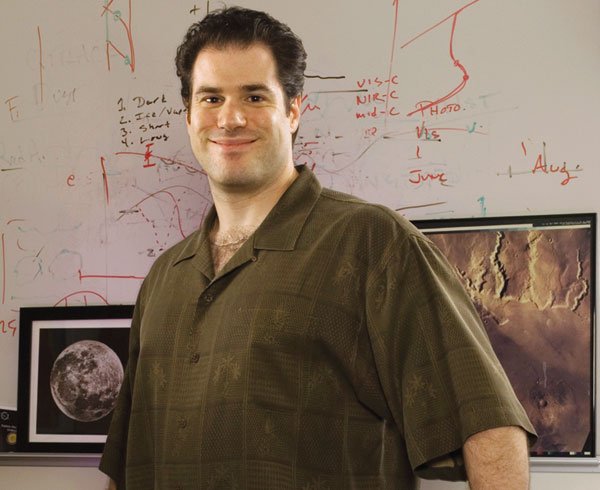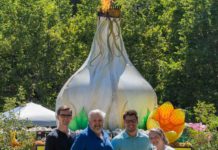If America finds water on the moon, Morgan Hill residents might
just want to walk down the street and thank their neighbor.
If America finds water on the moon, Morgan Hill residents might just want to walk down the street and thank their neighbor.
On June 18 at 2:32 p.m., NASA launched the Atlas V rocket from the Cape Canaveral Air Force Station in Florida. The rocket carries a Lunar Crater Observation and Sensing Satellite – known informally as LCROSS – which will crash into the moon in about four months. When the satellite hits the moon, it will use special equipment to determine if the moon dust it stirs up contains ice. If it does, shouts of celebration will be heard in Morgan Hill and Gilroy, home to several of the people who held prominent positions in the launch.
John Marmie, a Morgan Hill resident and the mission’s Deputy Project Manager, was in Florida for the launch and ran upstairs to the top of the building to watch the craft take flight. When the rocket reached the clouds, it began to crackle, he said.
“It was absolutely incredible,” Marmie said.
The satellite will circle Earth three times before spending months hurtling through space to the moon. The rocket also contained a Lunar Reconnaissance Orbiter, which will explore the effects of lunar radiation on humans. It entered orbit around the moon Tuesday.
The top part of the rocket that holds the satellite, called the Centaur upper stage, weighs 4,850 pounds – about as much as an SUV – and will hit the moon at 5,600 miles per hour – much faster than a bullet – said Dave Capka, a Southern California satellite enthusiast.
When the satellite and rocket nose hit the moon, they will stir up 250 tons of material into a cloud that will tower 30 miles high, Capka said. The satellite will then perform tests on this dust.
“We’re looking to see if there is water in the form of ice on the permanently shadowed craters of the moon,” said Gilroyan Rusty Hunt, one of the mission’s two alternating flight directors.
The water is not just for drinking, Hunt said.
“We could use it for air or rocket fuel. If we find it, it could change the course of our exploration,” he said.
The rocket is scheduled to reach the moon Oct. 9 – Hunt’s birthday.
“Flying the spacecraft into the moon … and hopefully finding water – that would be quite a present,” he said.
His wife, Tamra Scott-Hunt was also excited to see the launch as it meant she got her husband back, she said.
“We’d eat dinner and over 50 percent of the time he’d say ‘I’m sorry honey, I have to go back to work,'” she said.
Yet, Scott-Hunt identifies with Hunt’s love of space – they both grew up watching the Apollo 11 space mission and the first steps on the moon.
Hunt typically works a shift from midnight to noon, with an hour overlap on each side of his shift to bring the next flight controller up to date. Since the satellite mission is relatively small, there are only two shifts of flight directors. The teams alternate planning activities and executing maneuvers in space.
On Monday, the satellite’s cameras were opened for the first time in space.
“We saw the stars out there right where they’re supposed to be,” Hunt said.
The stars were recorded in standard video, in infrared and with spectrometers, which look at light composition in energy bands.
“This is like his dream come true,” said Tamra Scott-Hunt.
Hunt’s two sisters remember him making model rockets when he was 6, she said.
Now, Hunt has his own little rocket enthusiast – his 5-year-old daughter, who he takes on his commute to Mountain View, where she goes to an employee preschool.
“I love my daddy and he’s a rocket man,” Emma Hunt said.
But Rusty Hunt is not the only Gilroy resident commuting to the control room. Darin Foreman, the systems engineer on the flight operations team, also heads north to a job that is a natural extension of a childhood filled with tinkering, he said.
“I actually had a car and rebuilt the engine before I could even drive,” he said.
For Foreman, the mission is about sharing a love of the “hard sciences,” such as engineering and physics.
“We just want to get children excited about engineering-type things,” he said.
For Marmie, the dream of working at NASA didn’t materialize until graduate school. Marmie grew up near the Appalachian Mountains, but after becoming an electrical engineer with a specialty in electromagnetics, he decided it was time to get out.
“I sent out resumes to actually everywhere that ended in ‘beach,'” he said.
He ended up with a job at NASA and 20 years later, he is still there.
“In the Silicon Valley, staying for 20 years surprises some people,” Marmie said.
He almost left during he “dot-com” flurry but found NASA projects too interesting.
The excitement of the mission is not relegated to NASA employees – anybody with a telescope with a 10- to 12-inch diameter will be able to see the dust clouds from the satellite impact.
“It’s going to be a fantastic event for amateur astronomers,” Marmie said.
Sharing the experience is also part of the mission because NASA’s success is generated by more than just machines, said NASA Public Affairs Officer Jonas Dino
“There are people behind this,” he said. “It’s not just technology. There are hard working people thinking outside the box.”
To see videos of the rocket and from the rocket, click here.














